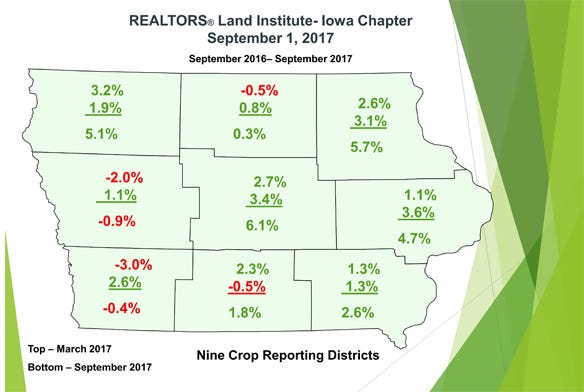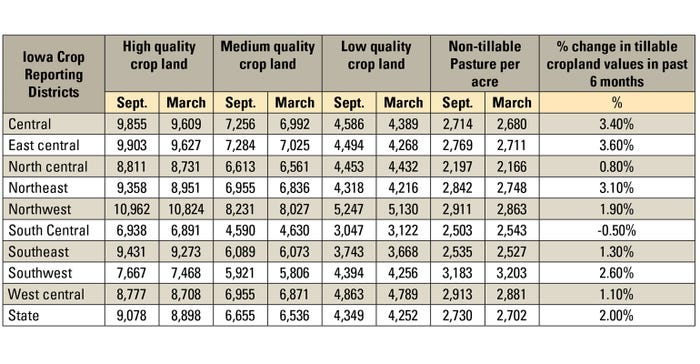
Despite stubbornly low crop prices, Iowa farmland prices have continued to show strength in 2017. The latest survey by the Iowa Chapter of the Realtors Land Institute shows Iowa cropland values rose 2% during the March to September period. Combined with a 0.9% increase in the prior six months, the annual gain was 2.9% from September 2016 to September 2017.
“The survey shows the first full-year statewide increase in land values since 2013, indicating some current stability,” says Kyle Hansen, real estate broker for Hertz Farm Management and chairman of the survey committee. Statewide average for cropland is estimated at $6,694 per acre, according to the survey released Sept 12.
Realtors participating in the survey cited a very limited supply of land on the market as a key reason for the land price increase. The lack of stable alternative investments, the amount of cash on hand and increasing interest rates also play a role, notes Hansen.
Other surveys show slight rise
The Realtor survey mirrors other recent surveys showing an uptick in Iowa cropland values in 2017. A report released in August by USDA showed a 1.9% gain in Iowa farmland prices over 2016. A survey of bankers by the Chicago Federal Reserve showed a 3% gain during the 12 months ending July 1.
The Iowa farm real estate survey showed gains in nearly all Iowa crop reporting districts during the past six months. The one exception was a 0.5% decline in the south-central region, which has been hit hard by drought in 2017. The biggest gains for the six months were in the north-central and east-central districts, both up 3.6%; central up 3.4%; and northeast up 3.1%. Cropland prices were up 1.9% in northwest Iowa, which saw some of the strongest land prices and gains a few years ago.

Looking at Iowa’s nine crop reporting districts, top number shows percent increase or decrease in cropland value as of March. The bottom number shows increase or decrease as of September. Example: South-central Iowa had a 2.3% increase for the six-month period prior to March, and a 0.5% decrease for the six months prior to September, ending up with a 1.8% increase for the year.

The Realtor survey shows a gain in pastureland prices in all but the south-central and southwest districts. There were also gains for non-tillable and timber acres in most districts.
 The Iowa Realtors Land Institute survey shows cropland values climbed 2.9% to an average of $6,694 per acre in Iowa for the year ending Sept. 1. The largest annual increase was in central Iowa at 6.1%, followed by northeast Iowa at 5.7% and northwest Iowa at 5.1%.
The Iowa Realtors Land Institute survey shows cropland values climbed 2.9% to an average of $6,694 per acre in Iowa for the year ending Sept. 1. The largest annual increase was in central Iowa at 6.1%, followed by northeast Iowa at 5.7% and northwest Iowa at 5.1%.

The full survey is available at rlifarmandranch.com. Participants in the survey are specialists in farmland and were asked for their opinions about the current status of the Iowa farmland market. They were asked to estimate the average value of farmland as of Sept. 1.
Has ag downturn turned corner?
After three years of decline and with Iowa farmland values rising nearly 3% in 2017, is this a signal the ag economic downturn has turned a corner? Probably not. Iowa’s farmland value increase could be just a “temporary break” from continued declines, says Chad Hart, an Iowa State University ag economist. “For land values to go back up again, you really need a reason,” he says. “The reason land values typically move is the income you can derive from the land. And right now, that income is still under stress.”
Since 2013, Iowa ag income has fallen nearly 70% to $2.6 billion last year. Nationally, farm income has dropped 50% to $65.1 billion. In August, USDA projected U.S. farm income would climb 3.1% this year, thanks primarily to an improved profit outlook for cattle, hogs and poultry. Hart doubts Iowa will see that kind of farm income improvement, given drought conditions that hit most of the state this summer.
Hart says some farmers who stashed large cash reserves from record commodity prices several years ago might be taking advantage of lower land prices to get good deals. Iowa farmland values have tumbled about 24% since peaking at $8,750 an acre in 2013, the Realtors Land Institute surveys show.
Profit margins expected to remain tight
But the financial pain is likely to continue for many farmers, especially those with high debt levels, says Hart. “We’re seeing a few more farmers than usual getting out of the business, which makes sense, given the tough financial conditions. Profits will be difficult to find this year and next.”
With big U.S. corn and soybean crops this year weighing on prices, a continued downturn in the farm economy could increase the number of farms for sale, which would reduce land values. Farmers might sell part of their acreage to raise money to continue farming, bringing more land supply onto the market. “It’s unclear where we go from here. A lot will depend on the crop size this year and next,” says Hansen.
If farmers, who make up about 80% of the land buyers, drop out of the market, land values could fall. Outside investors are more likely to look only at the land’s ability to produce income. Farmers, however, might pay higher prices to buy a neighbor’s land, given a limited amount of land available for purchases. Farmers don’t use purely economic reasoning when deciding to buy land.
About the Author(s)
You May Also Like




